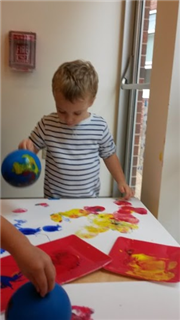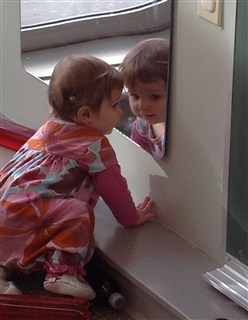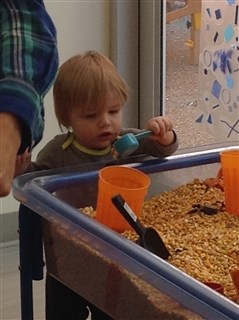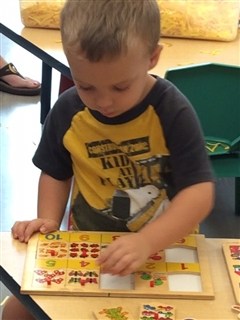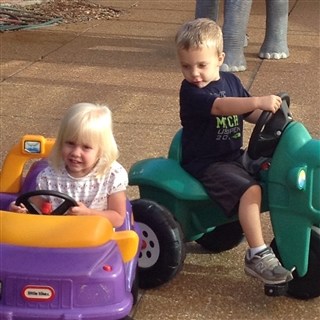Painting with Balloons
Counting Red Cranberries
Materials
Bag of cranberries
Styrofoam plates
Permanent Marker
Large container of water
Instructions
Using a permanent marker, write a numeral on each styrofoam plate and float them in a large container or tub filled with water. Empty the bag of cranberries into the water. They float well! Have child identify the numeral on one of the plates and place the appropriate number of cranberries onto the corresponding styrofoam plate. Continue with all remaining plates.
Extension: Invite child to remove each plate one at a time in numerical order.
Principia School Acorn Program
Games and Activities for Infants (0-3 months)
- Talk and sing to your newborn with your face about 12 inches away
- Have large pictures of faces available
- High-contrast patterns and colorful pictures
- Objects that move slowly and have a gentle sound/music
- Mobiles and hand-held toys that are held within the child’s line of vision (develops visual motor skills)
- Soft books with high-contrast patterns
- Unbreakable mirrors
- Sensory toys that squeak, twill, or tweet
- Sock and wrist rattles
- Wind chimes
- Tummy time – place baby on her tummy on a firm surface for brief intervals throughout the day; gives your baby practice in lifting her head; arrange things for her to look at when on her tummy
Games and Activities for Infants (3-6 months)
- Activity centers: bat at toys, spin them, pull them, rattle them
- Lightweight rattles that can be easily grasped
- Activity bars
- Soft, cuddly animals (no wires, buttons, ribbons, yarn)
- Squeaky rubber toys
- Board books (read often; helps language develop; vary sound of voice)
- Colorful teething rings
- Activity quilts and mats
- Play Peek-a-Boo
Games and Activities for Infants (6-9 months)
Your child’s play is becoming more vigorous. He can grab two toys at a time and he has more precision when banging objects. Fine motor skills are developing – growing dexterity which allows him to pick up raisins and Cheerios. Your child will begin to notice objects still exist even when he can’t see them. Your child will also become more mobile and will begin to pull himself up around nine months.
- Books – board, soft, cloth (reading becomes more interactive; let your child handle the books)
- Busy boards – parts that slide, twist, spin, squeeze, make sounds
- Soft dolls and stuffed animals
- Lightweight fabric balls to roll back and forth
- Household items – plastic bowls, plastic measuring cups and spoons; let your child “cook” next to you
- Wood or soft blocks – show how to stack, dump
- Moving and pop-up toys; toys with springy antennas
- Water toys for the tub
- Bounce baby; dance with baby
- Play Hide-n-Seek with objects and Peek-a-Boo
Games and Activities for Infants (9-12 months)
Your child will begin to use objects as tools – using a spoon to chase food around on the plate. He may enjoy interactive games such as tickling and letting him tickle you and “talking” on the phone. Problem-solving skills are beginning to develop and your child begins to understand words and recognize the names of familiar objects. He will likely want to put most objects into his mouth.
- Push toys and walkers
- Shape sorters or plastic containers with balls and objects (develops eye-hand coordination, visual-spatial relationships)
- Balls
- Toy telephones
- Books – pop-ups, textures, pull tabs
- Blocks – a must have for stacking and knocking over
- Pail and shovel
Games and Activities for Toddlers (18-24 months)
At this stage your child wants to be more independent, but still appreciates the help from you. Your child learns by getting her hands into everything. She will fiddle with knobs, open and shut doors, and flip light switches on and off. Toys with interlocking parts – pop-up toys, nesting toys, sorting toys, trucks with doors that open and shut – create endless opportunities to explore.
- Toys to play house
- Large and small blocks
- Toy instruments
- Puzzles
- Illustrated Books and CD’s – nursery rhymes; ask your child if he can name things seen in the pictures
- Train sets
Games and Activities for Toddlers (24-30 months)
At age two, your child may become more assertive, but her defiance really results from her desire for independence and her continuing need for help. Your child may be testing her limits.
- Ride-on toys (especially ones that “hold cargo”)
- Balls – soft ones for throwing; set up hoops using wastepaper baskets; a few will on occasion catch a ball; draw two lines and play a simplified game of soccer
- Art supplies that allow for creativity. Introduce tempera paints with various size paint brushes
- Percussive instruments – tambourines, rhythm sticks, drums; march to the beat of different music genres
- Dress-up clothes
- Child-size household equipment – vacuum cleaners, workbench, small table and chairs
- Construction toys
- Puzzles and manipulatives
Games and Activities for Toddlers (30-36 months)
Your child will want to learn to put on his own T-shirt, take off his own pants, and wash and dry his own hands. He may want to include other children in his games, and he’ll really begin to relate to and focus on other kids, which allows him to play more structured games.
As your child gets older, he will become increasingly imaginative. He will start developing his own story lines, characters, plots, and adventures. Giving him clothes and props for pretend play – something as simple as a cardboard box can be a wagon, a spaceship, a fort, and so on – will help encourage this area of development.
- Jigsaw Puzzles – look for ones with large, simple, and easy recognizable pictures; works on problem solving and eye/hand coordination
- Beginning board or memory games – Chutes and Ladders, I Spy, Memory
- Kitchen set
- Mega Blocks or Lego Duplos
- Art Supplies – crayons, clay, collage materials, watercolors, finger paints
- Outdoor equipment – swings, basketball hoops, bats, golf-sets, soccer balls
- Books that are age-appropriate and more sophisticated; your child can follow narratives and more complicated words and stories


